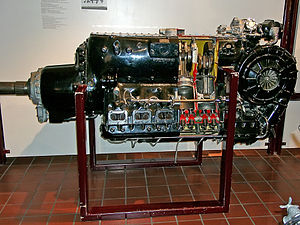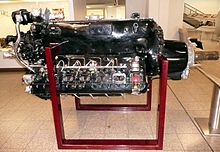- Daimler-Benz DB 603
-
DB 603 Preserved Daimler-Benz DB 603 with cutaway sections. Type Piston V12 aircraft engine National origin Germany Manufacturer Daimler-Benz First run 1940s Major applications Messerschmitt Me 410
Dornier Do 217
Focke-Wulf Ta 152Developed from Daimler-Benz DB 601 The Daimler-Benz DB 603 engine was a German aircraft engine used during World War 2. It was a liquid-cooled in-line 12 cylinder inverted V12 enlargement of the DB 601, which was in itself a development of the DB 600. Production of the DB 603 commenced in May 1942.[1]
The DB 603 powered several aircraft, including the Do 217 N&M, Do 335, He 219, Me 410 and Ta 152C.
Contents
Design and development
The Mercedes-Benz T80 land speed record car, designed by aircraft engineer Josef Mickl with assistance from Ferdinand Porsche and top German Grand Prix racing driver Hans Stuck, incorporated the third prototype DB 603. It ran on pure alcohol with MW injection and was tuned to 3,000 hp (2,200 kW) — enough, it was believed, to propel the aerodynamic three-axle T80 up to 750 km/h on the Dessau autobahn in January 1940 during Rekord Woche (Record/Speed Week). Due to the outbreak of the war in September 1939, the T80 (nicknamed Schwarz Vogel, "Black Bird") never raced. The DB 603 engine was removed from the vehicle for use in fighter aircraft.
Variants
Production versions
- DB 603A, rated altitude of 5.7 km, B4 fuel
- Power (max): 1287 kW (1750 PS) at 2700 rpm at sea level
- Combat power: 1162 kW (1580 PS) at 2500 rpm at sea level
- DB 603AA DB 603A with rated altitude of 7.3 km, B4 fuel
- Power (max): 1228 kW (1670 PS) at 2700 rpm at sea level
- Combat power: 1162 kW (1580 PS) at 2500 rpm at sea level
- DB 603E rated altitude of 7.0 km, B4 fuel
- Power (max): 1324 kW (1800 PS) at 2700 rpm at sea level
- Combat power: 1158 kW (1575 PS) at 2500 rpm at sea level
Prototypes and other versions
- DB 603D, a DB 603A with propellers rotating counter-clockwise; production unknown
- DB 603F, a DB 603E with propellers rotating counter-clockwise; production unknown
- DB 603G (production cancelled)
- Power (max): 1397 kW (1900 PS) at 2700 rpm at sea level
- Combat power: 1147 kW (1560 PS) at 2700 rpm at sea level
- DB 603L/LA (prototype with two-stage supercharger, B4 fuel)
- Power (max): 1471 kW (2000 PS)
- DB 603N (prototype with two-stage supercharger, C3 fuel)
- Power (max): 2059 kW (2800 PS) at 3000 rpm at sea level
- Continuous: 1420 kW (1930 PS) at 2700 rpm at sea level
- DB 603S (DB 603A with experimental TK-11 turbo-supercharger)
- Power (max): Not known.
- DB 613 Series of experimental "power system" coupled side-by-side twinned DB 603s, arranged as the DB 606 and DB 610 had been previously, and meant to replace the 606 and 610, in prototype form only from March 1940 through 1943.
- Power (max): Not known.
- DB 614 a 2000hp development.
- DB 615 Coupled DB 614 engines
- DB 617 A long-range derivative of the DB603
- DB 618 Coupled DB617 engines
- DB 622 A DB 603 with a two-stage super charger and single stage turbocharger
- DB 623 A DB603 with twin turbochargers
- DB 624 A DB 603 with a two-stage super charger and single stage turbocharger
- DB 626 A DB603 with twin turbochargers and intercooler
- DB 627 The DB603 fitted with a two-stage supercharger and after-cooler.
- DB 631 An abandoned three stage supercharged DB603G.
- DB 632 A projected development of the DB603N with contra-rotating propellers.
- MB 509 Development as a tank engine for the super-heavy Panzer VIII Maus[2]
All power data is given in metric horsepower as stated per manufacturer. Power (max) is Takeoff and Emergency power (5-min-rating), combat power is climb and combat power (30-min rating), continuous is without time limit.
Applications
- Blohm & Voss BV 155
- Blohm & Voss BV 238
- Dornier Do 217
- Dornier Do 335
- Fiat G.56 - two prototypes flown
- Focke-Wulf Ta 152
- Heinkel He 177B - prototype aircraft series
- Heinkel He 219
- Heinkel He 274
- Macchi MC.207 - experimental installation, not flown
- Messerschmitt Me 410
- Reggiane Re.2006- experimental installation, not flown
Specifications (DB 603A)
Data from Jane's[3]
General characteristics
- Type: 12-cylinder liquid-cooled supercharged inverted Vee aircraft piston engine
- Bore: 162 mm (6.38 in)
- Stroke: 180 mm (7.09 in)
- Displacement: 44.52 L (2,716.9 in3)
- Length: 2610.5 mm (102.8 in)
- Diameter: 830 mm (32.7 in)
- Dry weight: 920 kg (2,030 lb)
Components
- Supercharger: Gear-driven centrifugal type supercharger
- Fuel system: Direct fuel injection
- Cooling system: pressurized water cooling
Performance
- Power output:
- 1,287 kW (1,750 PS) for takeoff
- 1,111 kW (1,510 PS) maximum continuous
- Specific power: 26.7 kW/L (0.59 hp/in³)
- Compression ratio: 7.5:1 left cylinder bank, 7.3:1 right cylinder bank
- Specific fuel consumption: 0.288 kg/(kW·h) (0.474 lb/(hp·h))
- Power-to-weight ratio: 1.29 kW/kg (0.79 hp/lb)
See also
- Related development
- Comparable engines
- Related lists
References
Notes
- ^ Gunston 1989, p.48.
- ^ "Panzer VIII Maus". Achtung Panzer. http://www.achtungpanzer.com/panzerkampfwagen-viii-maus-porsche-typ-205-tiger-iip.htm.
- ^ Jane's 1989, p.290.
Bibliography
- Gunston, Bill. World Encyclopedia of Aero Engines. Cambridge, England. Patrick Stephens Limited, 1989. ISBN 1-85260-163-9
- Jane's Fighting Aircraft of World War II. London. Studio Editions Ltd, 1989. ISBN 0-517-67964-7
- Neil Gregor Daimler-Benz in the Third Reich. Yale University Press, 1998
External links
Daimler-Benz aircraft engines Piston engines Turbofans 109-007 · DB 730
Turboprops/Turboshafts 109-021 · DB 720 · DB 721
Lists relating to aviation General Aircraft (manufacturers) · Aircraft engines (manufacturers) · Airlines (defunct) · Airports · Civil authorities · Museums · Registration prefixes · Rotorcraft (manufacturers) · TimelineMilitary Accidents/incidents Records Categories:- Daimler-Benz aircraft engines
- Aircraft piston engines 1940-1949
Wikimedia Foundation. 2010.


